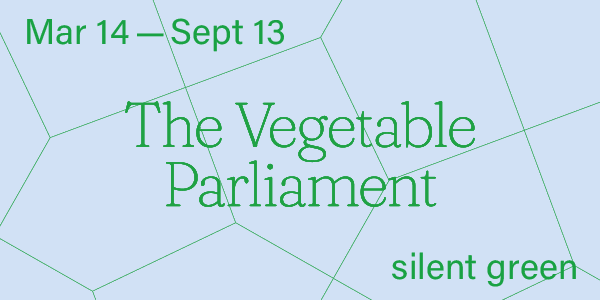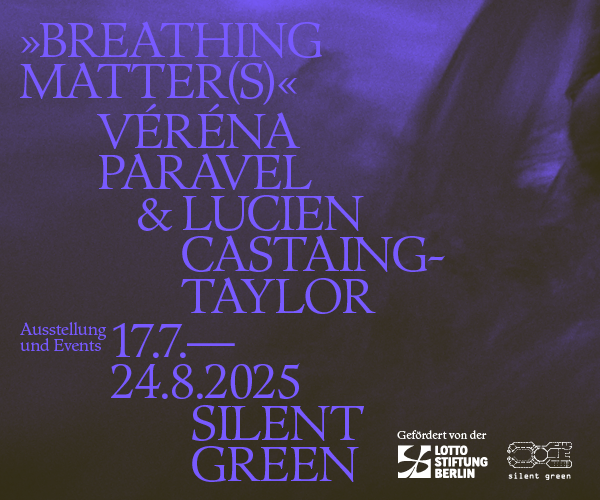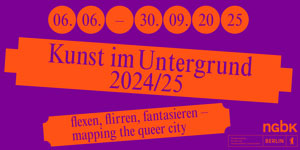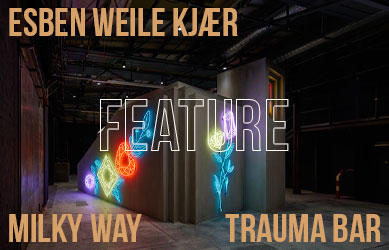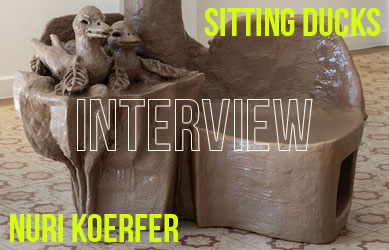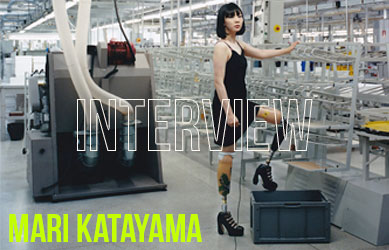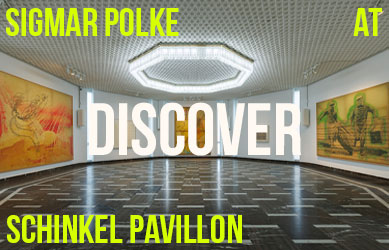by Chris Erik Thomas // July 21, 2025
There’s a theatrical flair to Mario García Torres’ fifth solo exhibition at neugerriemschneider. In ‘nada me han enseñado los años (All the years have taught me nothing),’ on view through August 23rd, a new series of black-and-white oil paintings have been arranged like a storyboard and offset by a rusty orange-hued carpet, freshly installed in the gallery’s Linienstraße location for the show and dotted with shoe prints of visitors as they wander from one work to the next. “I thought of the exhibition as something quite atmospheric,” García Torres told Berlin Art Link. “It’s built with a cinematic structure, so I wanted to create [narrative] space.”
The result is an atmospheric and cinematic restructuring of the gallery space. The exhibition marks a bold new chapter in the Mexican artist’s practice; one that sees García Torres shift his focus to his homeland after years spent probing more global themes, and experiment with both figuratism and Artificial Intelligence tools. Forming the core of the series are four works that engage with the lives and legacy of Mexican poet Salvador Novo and Cuban Communist Party founding member Julio Antonio Mella. While elsewhere, some of the largest works in the series are dedicated not to the past, but to the digital present in the form of internet memes—a cat giving a thumbs up with tears in its eyes forms the narrative conclusion of the essayistic exhibition.
By digging through both historical and contemporary cultural artifacts, and then recontextualizing and algorithmically distorting these influences, García Torres takes aim at the malleability of truth and myth-making. In our conversation, the artist muses on the transformative freedom of repetition as he cites photocopy machines and running his own meme account as key tools in his creative practice.

Mario García Torres: ‘I Painted This Shy Cat Doing an Impossible Thumbs Up on a Large Canvas Because I Thought It Could Be a Surreal, Relevant Image,’ n.d. // © Mario García Torres, courtesy the artist and neugerriemschneider, Berlin, photo by Omar Bocanegra, Mexico City
Chris Erik Thomas: The show marks the first time you’ve incorporated both figuration and Artificial Intelligence tools into your works. What prompted you to explore these elements?
Mario García Torres: My lucky moment was when I realized that all the discussion about “what is truth and what is not” starts with AI; it is proposing something new, but at the same time, it’s not. Where is fiction really starting? People say that nothing is ever new and that it’s always coming from something else, and the discussion with AI is the same. All of these things the AI was filling me with were also in my own history. That’s when the project started to be less conceptual and became a bit more grounded in a specific story.
I hope that I’ve managed to create an atmosphere, but also give [the show] a kind of narrative theatricality. It’s at the core of the project. It’s not only about the form, but also the histories that are being told.
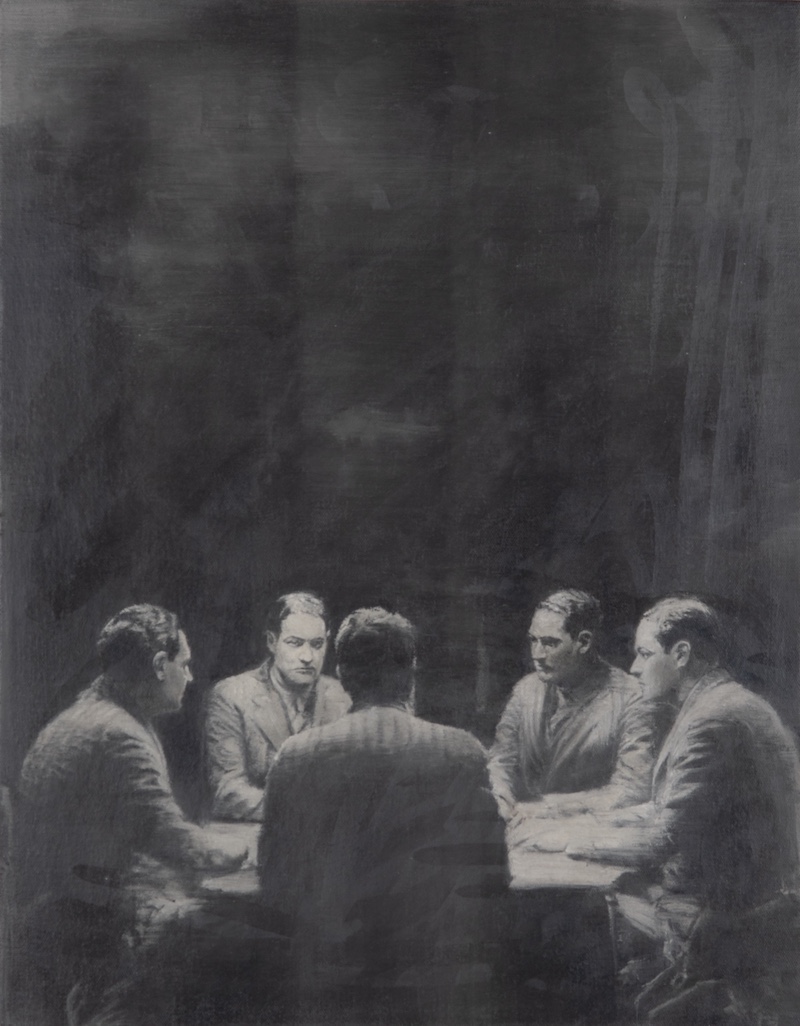
Mario García Torres: ‘Portrait of a Mischievous Writer and Acute Critic of Early-20th-Century Intellectual Life in Mexico, Who Also Played an Important Role in the Development of Theater of the Era (Salvador Novo),’ n.d. // © Mario García Torres, courtesy the artist and neugerriemschneider, Berlin, photo by Omar Bocanegra, Mexico City
CET: In a way, the show is like a homecoming because you focus on your own country’s cultural history for the first time. Your past works had a more global perspective. Why did you decide to make that shift?
MGT: At the beginning of my career, it had to do with transcending my own condition. In a developed country, you go to [art] school and going to school allows you to say you’re an artist. But in a country like Mexico, there isn’t such a clear, black-and-white structure. You have to legitimize yourself and believe in yourself. When you look at the career of artists from developed countries, you say, “What’s your first piece?” And they say, “My graduation show is my first piece.” But if you ask that to a Mexican artist, they will say they don’t know, because you’re publicly trying things until one day you say: “Maybe this is working. Maybe I’m an artist.”
In my case, I thought that my way to legitimate myself was to talk in the language of the other. The only way to exist in Mexico [as an artist] was to have an impact somewhere else. Now this has become more blurry, and it’s more interesting. So, for me, I thought I might as well look here, and it’s like finding out that you had the key in your pocket the whole time. In Mexico, there has been a lot of thought about what is reality and what is truth. We have been living, in at least the last 100 years, in a space where things are not black and white.
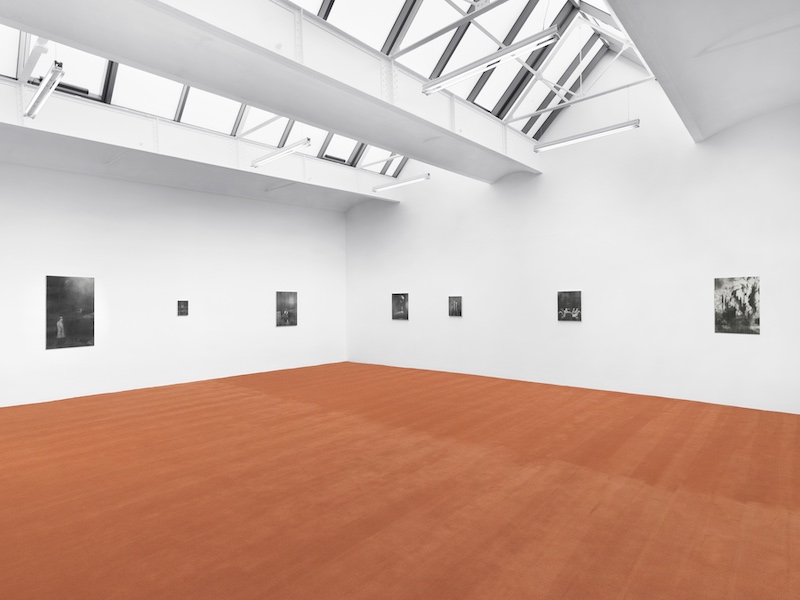
Mario García Torres: ‘nada me han enseñado los años,’ 2025, installation view at neugerriemschneider, Berlin // © Mario García Torres, courtesy the artist and neugerriemschneider, Berlin, photo by Jens Ziehe, Berlin
CET: A key part of the show’s narrative is its use of meme culture. Why did you incorporate this aspect of digital culture into your work?
MGT: I run my own meme account. People know about it now, but it was a secret for many years. In the last few years, it started to influence my artistic work. It’s a fascinating space because it’s very much related to conceptual art; the idea of text being used to change the meaning of an image is quite interesting. My main question with memes is, what makes them circulate? I have my own account, and I never know which one is going to be popular, which is really strange. With most things in life, you know what would be potentially interesting for people or have an impact. In meme culture, it’s such an immediate thing. It either hits immediately, or it gets discarded. Sometimes the same image says something new. You post it two years later, and it works better than it did initially.
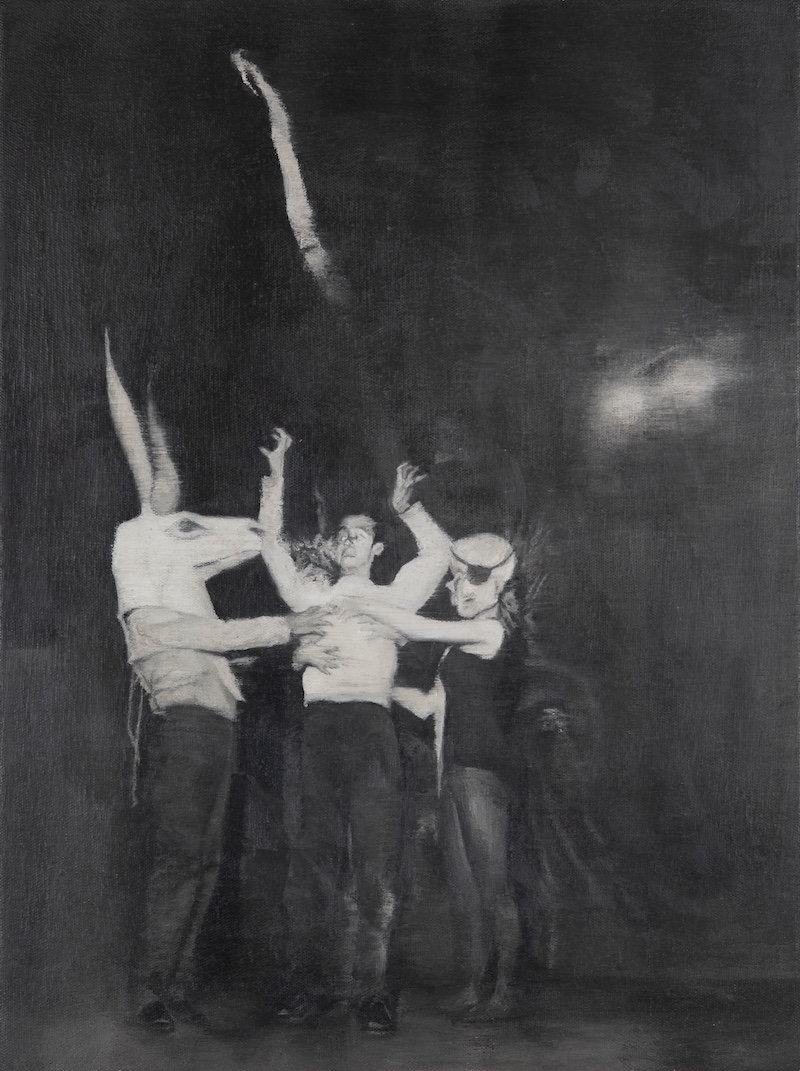
Mario García Torres: ‘A Strange Moment Painted After a Photograph of What I Believe to Be a Rehearsal for a Theater Piece by Leonora Carrington,’ n.d. // © Mario García Torres, courtesy the artist and neugerriemschneider, Berlin, photo by Omar Bocanegra, Mexico City
CET: I’m curious about the technical process behind the paintings and why you decided to render everything in black and white. Walk me through the layers to creating these works.
MGT: The way that the show is structured, there are some very specific stories and then there are some works that I call “B-Roll images.” You have the candles, the birds. It’s cinematic. It’s very important when you’re telling a story to give space to think and to take in what just happened. Some of the B-Roll starts with AI, and others come from more archival images that I eventually also edit.
I wanted to do something about reproduction. There’s something poetic about the fact that life repeats itself. I’ve been working for a long time with the idea that repetition is never repetition; it’s a space for a story to be told differently. My more conceptual background inspired me to create proper oil paintings, but with the look of coming out of a photocopy machine. Most of my art history lessons came from photocopies, [but now] screenshots are the new photocopies.
The project I was working on before was a series of paintings made with the toner dust from photocopy machines. Now, instead of putting them in the photocopy, I was painting the photocopy. That’s what technically happens in most of the works. I get the image and sometimes use AI to expand it and edit it. In that process, weird things appear, which is also quite interesting. After that, they go through the photocopy machine, and sometimes I force the machine to make mistakes, so the copy becomes a bit weirder.
These paintings are something that people probably don’t expect from me. In a way, it feels like a risk. I’ve done [similar] works, but they were always grounded in a very conceptual exercise. Here, there’s a little bit more space to fail. It gets more slippery. Mistakes and vulnerability are what make us human. That is the message. I don’t believe in perfection, and I’m not interested in things being black and white; I’m interested in a more humanized message. I hope that all these glitches and mistakes actually make the work more relatable to people.
Exhibition Info
neugerriemschneider
Mario García Torres: ‘Nada me han enseñado los años’
Exhibition: July 12-Aug. 23, 2025
gallery-weekend-berlin.de/neugerriemschneider
Linienstraße 155, 10115 Berlin, click here for map



